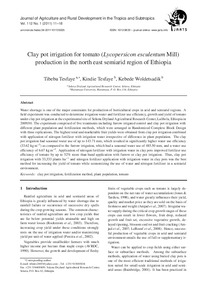Aufsatz

Clay pot irrigation for tomato (Lycopersicon esculentum Mill) production in the north east semiarid region of Ethiopia
Abstract
Water shortage is one of the major constraints for production of horticultural crops in arid and semiarid regions. A field experiment was conducted to determine irrigation water and fertilizer use efficiency, growth and yield of tomato under clay pot irrigation at the experimental site of Sekota Dryland Agricultural Research Center, Lalibela, Ethiopia in 2009/10. The experiment comprised of five treatments including furrow irrigated control and clay pot irrigation with different plant population and fertilization methods, which were arranged in Randomized Complete Block Design with three replications. The highest total and marketable fruit yields were obtained from clay pot irrigation combined with application of nitrogen fertilizer with irrigation water irrespective of difference in plant population. The clay pot irrigation had seasonal water use of up to 143.71 mm, which resulted in significantly higher water use efficiency (33.62 kg m^-3) as compared to the furrow irrigation, which had a seasonal water use of 485.50 mm, and a water use efficiency of 6.67 kg m^-3. Application of nitrogen fertilizer with irrigation water in clay pots improved fertilizer use efficiency of tomato by up to 52% than band application with furrow or clay pot irrigation. Thus, clay pot irrigation with 33,333 plants ha^-1 and nitrogen fertilizer application with irrigation water in clay pots was the best method for increasing the yield of tomato while economizing the use of water and nitrogen fertilizer in a semiarid environment.
Citation
In: Journal of Agriculture and Rural Development in the Tropics and Subtropics. Kassel : Kassel University Press. - Vol. 112, No. 1 (2011), S. 11-18Collections
Vol 112, No 1 (2011) (Journal of Agriculture and Rural Development in the Tropics and Subtropics (JARTS))Citation
@article{urn:nbn:de:hebis:34-2011101139325,
author={Tesfaye, Tibebu and Tesfaye, Kindie and Woldetsadik, Kebede},
title={Clay pot irrigation for tomato (Lycopersicon esculentum Mill) production in the north east semiarid region of Ethiopia},
year={2011}
}
0500 Oax 0501 Text $btxt$2rdacontent 0502 Computermedien $bc$2rdacarrier 1100 2011$n2011 1500 1/eng 2050 ##0##urn:nbn:de:hebis:34-2011101139325 3000 Tesfaye, Tibebu 3010 Tesfaye, Kindie 3010 Woldetsadik, Kebede 4000 Clay pot irrigation for tomato (Lycopersicon esculentum Mill) production in the north east semiarid region of Ethiopia / Tesfaye, Tibebu 4030 4060 Online-Ressource 4085 ##0##=u http://nbn-resolving.de/urn:nbn:de:hebis:34-2011101139325=x R 4204 \$dAufsatz 4170 7136 ##0##urn:nbn:de:hebis:34-2011101139325
<resource xsi:schemaLocation="http://datacite.org/schema/kernel-2.2 http://schema.datacite.org/meta/kernel-2.2/metadata.xsd"> 2012-01-16T12:42:36Z 2012-01-16T12:42:36Z 2011 1612-9830 urn:nbn:de:hebis:34-2011101139325 http://hdl.handle.net/123456789/2011101139325 eng Kassel University Press Urheberrechtlich geschützt https://rightsstatements.org/page/InC/1.0/ clay pot irrigation fertilization method plant population tomato 630 Clay pot irrigation for tomato (Lycopersicon esculentum Mill) production in the north east semiarid region of Ethiopia Aufsatz Water shortage is one of the major constraints for production of horticultural crops in arid and semiarid regions. A field experiment was conducted to determine irrigation water and fertilizer use efficiency, growth and yield of tomato under clay pot irrigation at the experimental site of Sekota Dryland Agricultural Research Center, Lalibela, Ethiopia in 2009/10. The experiment comprised of five treatments including furrow irrigated control and clay pot irrigation with different plant population and fertilization methods, which were arranged in Randomized Complete Block Design with three replications. The highest total and marketable fruit yields were obtained from clay pot irrigation combined with application of nitrogen fertilizer with irrigation water irrespective of difference in plant population. The clay pot irrigation had seasonal water use of up to 143.71 mm, which resulted in significantly higher water use efficiency (33.62 kg m^-3) as compared to the furrow irrigation, which had a seasonal water use of 485.50 mm, and a water use efficiency of 6.67 kg m^-3. Application of nitrogen fertilizer with irrigation water in clay pots improved fertilizer use efficiency of tomato by up to 52% than band application with furrow or clay pot irrigation. Thus, clay pot irrigation with 33,333 plants ha^-1 and nitrogen fertilizer application with irrigation water in clay pots was the best method for increasing the yield of tomato while economizing the use of water and nitrogen fertilizer in a semiarid environment. open access In: Journal of Agriculture and Rural Development in the Tropics and Subtropics. Kassel : Kassel University Press. - Vol. 112, No. 1 (2011), S. 11-18 Tesfaye, Tibebu Tesfaye, Kindie Woldetsadik, Kebede Gedruckte Ausg. im Verlag Kassel Univ. Press (www.upress.uni-kassel.de) erschienen. </resource>
The following license files are associated with this item:
Urheberrechtlich geschützt

